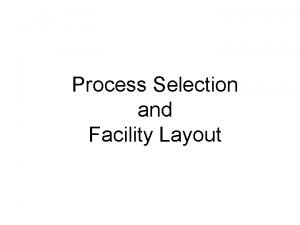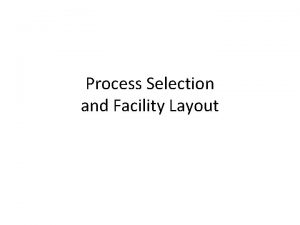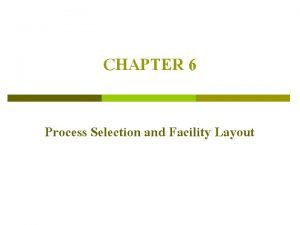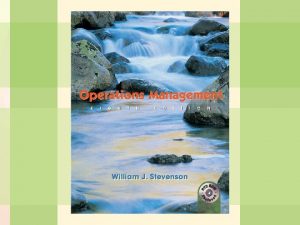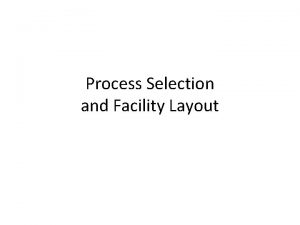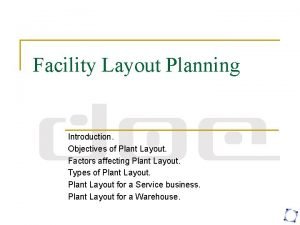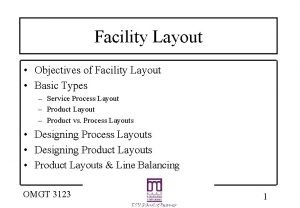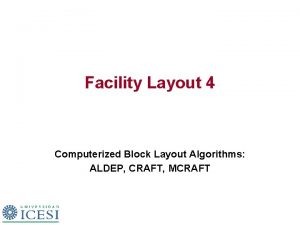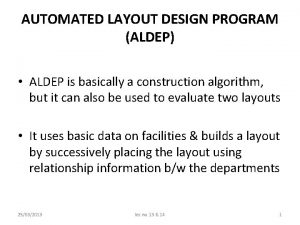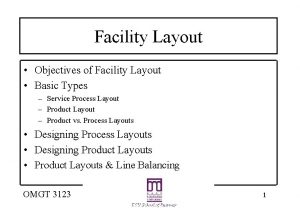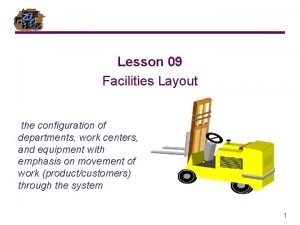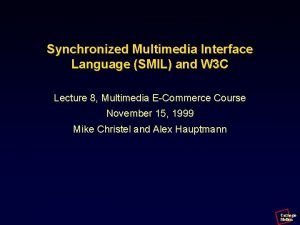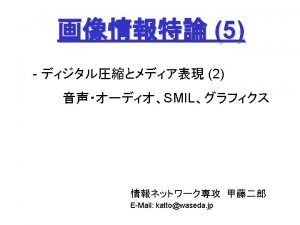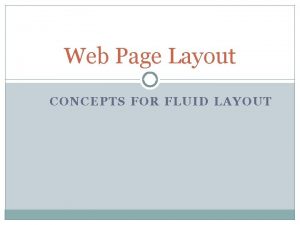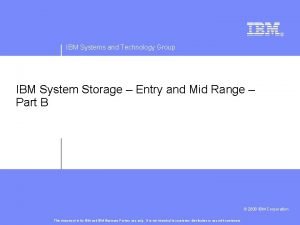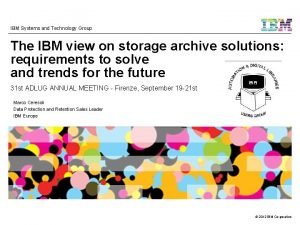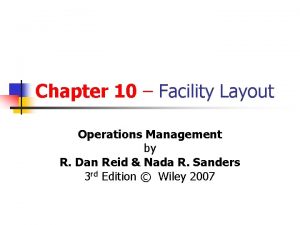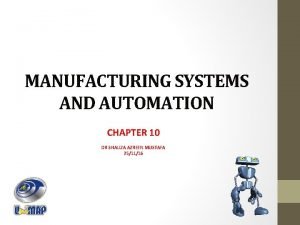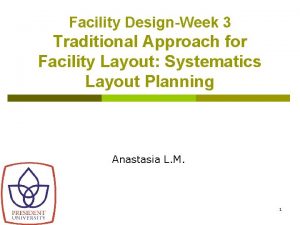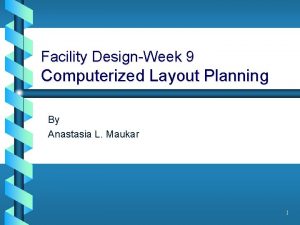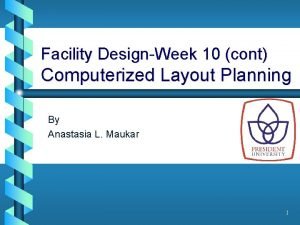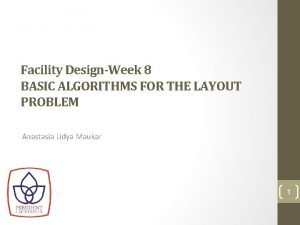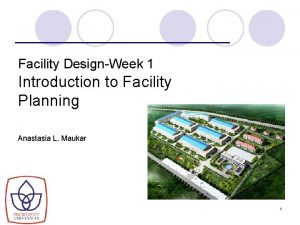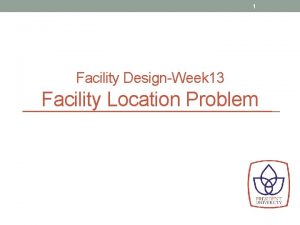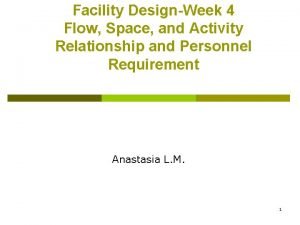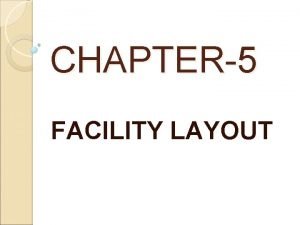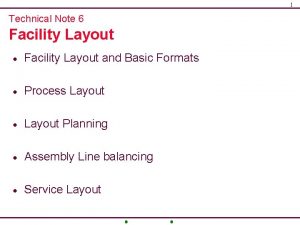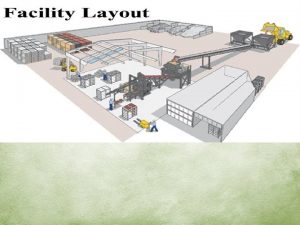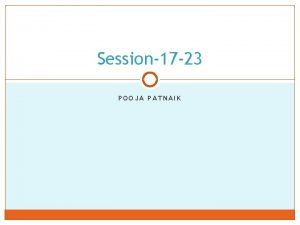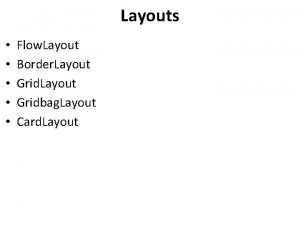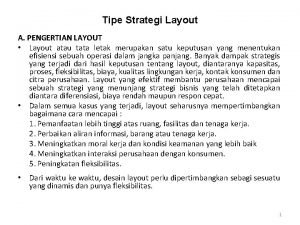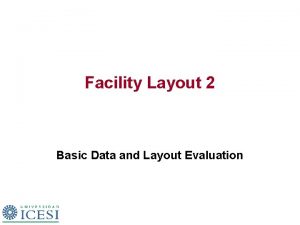Facility DesignWeek 6 Group Technology and Facility Layout










































- Slides: 42

Facility Design-Week 6 Group Technology and Facility Layout Anastasia L. Maukar 1

Introduction 2 l Group technology was introduced by Frederick Taylor in 1919 as a way to improve productivity. l One of long term benefits of group technology is it helps implement a manufacturing strategy aimed at greater automation.

WHAT IS GROUP TECHNOLOGY? Group technology (GT) is a philosophy that implies the notion of recognizing and exploiting similarities in three different ways: 1. By performing like activities together 2. By standardizing similar tasks 3. By efficiently storing and retrieving information about recurring problems 3

What is Group Technology l 4 Group Technology examines products, parts and assemblies. It then groups similar items to simplify design, manufacturing, purchasing and other business processes.

Benefits of GT and Cellular Manufacturing (CM) REDUCTIONS l Setup time l Inventory l Material handling cost l Direct and indirect labor cost 5 IMPROVEMENTS l Quality l Material Flow l Machine and operator Utilization l Space Utilization l Employee Morale

Group technology emphasis on part families based on similarities in design attributes and manufacturing, therefore GT contributes to the integration of CAD and CAM. 6

The Basic Key Features for a Successful Group Technology Applications: • Group Layout • Short Cycle Flow Control • A Planned Machine Loading 7

Process layout 8

Group technology layout 9

Sample part-machine processing indicator matrix 10

Rearranged part-machine processing indicator matrix 11

Rearranged part-machine processing indicator matrix 12

Rearranged part-machine processing indicator matrix 13

Classification and Coding Schemes l l l 14 Hierarchical Non-hierarchical Hybrid

Classification and Coding Schemes 15

Classification and Coding Schemes 16

Advantages of Classification and Coding Systems l l l 17 Maximize design efficiency Maximize process planning efficiency Simplify scheduling

Clustering Approach l l l 18 Rank order clustering Bond energy Row and column masking Similarity coefficient Mathematical Programming

Rank Order Clustering Algorithm Step 1: Assign binary weight BWj = 2 m-j to each column j of the part-machine processing indicator matrix. Step 2: Determine the decimal equivalent DE of the binary value of each row i using the formula Step 3: Rank the rows in decreasing order of their DE values. Break ties arbitrarily. Rearrange the rows based on this ranking. If no rearrangement is necessary, stop; otherwise go to step 4. 19

Rank Order Clustering Algorithm Step 4: For each rearranged row of the matrix, assign binary weight BWi = 2 n-i. Step 5: Determine the decimal equivalent of the binary value of each column j using the formula Step 6: Rank the columns in decreasing order of their DE values. Break ties arbitrarily. Rearrange the columns based on this ranking. If no rearrangement is necessary, stop; otherwise go to step 1. 20

Rank Order Clustering – Example 1 21

Rank Order Clustering – Example 1 22

Rank Order Clustering – Example 1 23

Rank Order Clustering – Example 1 24

ROC Algorithm Solution – Example 1 25

Bond Energy Algorithm Step 1: Set i=1. Arbitrarily select any row and place it. Step 2: Place each of the remaining n-i rows in each of the i+1 positions (i. e. above and below the previously placed i rows) and determine the row bond energy for each placement using the formula Select the row that increases the bond energy the most and place it in the corresponding position. 26

Bond Energy Algorithm Step 3: Set i=i+1. If i < n, go to step 2; otherwise go to step 4. Step 4: Set j=1. Arbitrarily select any column and place it. Step 5: Place each of the remaining m-j rows in each of the j+1 positions (i. e. to the left and right of the previously placed j columns) and determine the column bond energy for each placement using the formula Step 6: Set j=j+1. If j < m, go to step 5; otherwise stop. 27

BEA – Example 2 28

BEA – Example 2 29

BEA – Example 2 30

BEA – Example 2 31

BEA Solution – Example 2 32

Row and Column Masking Algorithm Step 1: Draw a horizontal line through the first row. Select any 1 entry in the matrix through which there is only one line. Step 2: If the entry has a horizontal line, go to step 2 a. If the entry has a vertical line, go to step 2 b. Step 2 a: Draw a vertical line through the column in which this 1 entry appears. Go to step 3. Step 2 b: Draw a horizontal line through the row in which this 1 entry appears. Go to step 3. Step 3: If there any 1 entries with only one line through them, select any one and go to step 2. Repeat until there are no such entries left. Identify the corresponding machine cell and part family. Go to step 4. 33 Step 4: Select any row through which there is no line. If there are no such rows, STOP. Otherwise draw a horizontal line through this row, select any 1 entry in the matrix through which there is only one line and go to Step 2.

R&CM Algorithm – Example 3 34

R&CM Algorithm – Example 3 35

R&CM Algorithm - Solution 36

Similarity Coefficient (SC) Algorithm 37

SC Algorithm – Example 4 38

SC Algorithm – Example 4 39

SC Algorithm – Example 4 40

SC Algorithm – Example 4 41

SC Algorithm Solution – Example 4 42
 Example of group technology layout
Example of group technology layout Group technology layout example
Group technology layout example Importance of process selection and facility layout
Importance of process selection and facility layout Disadvantages of facility layout
Disadvantages of facility layout Process selection and facility layout pdf
Process selection and facility layout pdf Chapter 6 process selection and facility layout
Chapter 6 process selection and facility layout Process selection and facility layout
Process selection and facility layout Process selection and facility layout
Process selection and facility layout Location layout
Location layout What is plant layout in commerce
What is plant layout in commerce What are the objective of plant layout
What are the objective of plant layout Load summary chart
Load summary chart Service facility layout
Service facility layout Computerized relative allocation of facilities technique
Computerized relative allocation of facilities technique Objectives of facility layout
Objectives of facility layout Aldep algorithm example
Aldep algorithm example Objectives of layout
Objectives of layout Facilities layout
Facilities layout Numerator layout vs denominator layout
Numerator layout vs denominator layout Language
Language Cddat
Cddat Fluid layout vs fixed layout
Fluid layout vs fixed layout Cx4-120 iops
Cx4-120 iops Ibm systems and technology group
Ibm systems and technology group Ibm systems and technology group
Ibm systems and technology group Rank order clustering algorithm
Rank order clustering algorithm Ibm systems and technology group
Ibm systems and technology group Product vs process layout
Product vs process layout Anova within group and between group
Anova within group and between group Voluntary group and involuntary group examples
Voluntary group and involuntary group examples Amino group and carboxyl group
Amino group and carboxyl group Amino group and carboxyl group
Amino group and carboxyl group Group 1 vs group 2 specialties
Group 1 vs group 2 specialties Joining together group theory and group skills
Joining together group theory and group skills Beringer technology group
Beringer technology group Contoh group technology
Contoh group technology Encore technology group
Encore technology group Btg biomass technology group bv
Btg biomass technology group bv Berkeley law & technology group llp
Berkeley law & technology group llp Monocode and polycode
Monocode and polycode Group technology
Group technology China titans energy technology group
China titans energy technology group Group polarization simple definition
Group polarization simple definition


